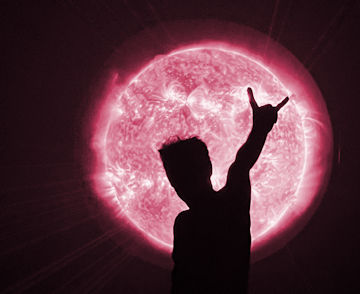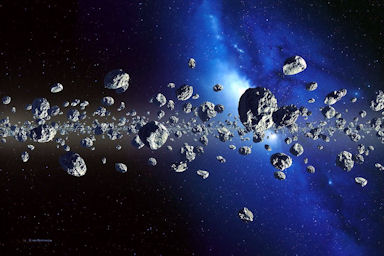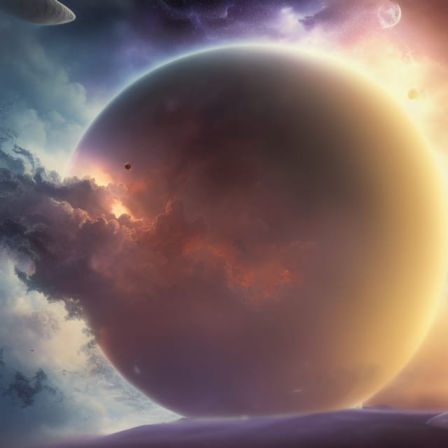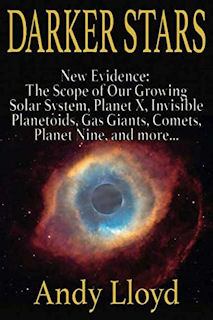Andy Lloyd's Dark Star Blog


Blog 92 (2023-24)
Puzzling Brown Dwarf Aurora
The study of brown dwarfs has been enhanced by the James Webb telescope, which can peruse the spectra of light from these objects in ever finer detail. It is also managing to study brown dwarfs in parts of the electromagnetic spectrum previously untouched by other telescopes (1). This new capability has flung up a very unexpected finding about a 'cold', isolated brown dwarf, W1935, that has no host star (2). The methane in its upper atmosphere is actually emitting light, rather than just absorbing it. Such a condition implies an active aurora display. However, there is no host star present to provide the solar wind which would normally drive such a light display. The implication is that the upper atmosphere of W1935 has far more energy packed into it than its low temperature (around 200C) would allow.
Image Credit: NASA, ESA, CSA, and L. Hustak (STScI)
Scientists suggest that a nearby active moon may be driving some of this activity, presumably through strong volcanic activity (rather like Io in orbit around Jupiter). Or instead the activity may be driven by internal atmospheric mechanisms transferring energy to the brown dwarf's upper atmosphere (a phenomenon observed on Saturn and Jupiter) or "external interactions with either interstellar plasma" (2).
So, here we have an isolated, cold 'Dark Star' which is independently emitting auroral light. This is a prediction I made many, many years ago in my book 'Dark Star' (3). At the time, I argued that these cold, failed star objects would be capable of giving out dim levels of light despite essentially appearing to be 'dead'. When discussing this, I often used to make an analogy with the glowing embers of a fire which has gone out. It's interesting to speculate that any moons orbiting a Dark Star such as W1935 would enjoy being bathed in the light from this auroral display. Indeed, the presence of such a moon might be helping to generate the effect itself!
Written by Andy Lloyd, 10th December 2024
1) Dr Sarah Casewell, interviewed on BBC Today programme 10/1/24
2) NASA Webb Telescope Team "NASA’s Webb Finds Signs of Possible Aurorae on Isolated Brown Dwarf" 9 January 2024
3) Andy Lloyd 'Dark Star: The Planet X Evidence" Timeless Voyager Press 2005
New Evidence for a Kuiper Belt Planet X
The theoretical basis for the existence of a large Planet X body continues to build, in spite of years of painstaking observations failing to reveal its actual whereabouts. The latest in a long line of science papers on this subject describes the results of computer simulations using a wide tranche of data sets about various features of out outer solar system, carried out by Japanese scientists (1, 2).
It concludes that there is an Earth-sized body located some 200 astronomical units away, describing an orbit that is inclined by 30 degrees from the ecliptic. This is much closer, and smaller, than the Super-Earth-sized Planet Nine proposed back in 2016 (3). It is larger, but further away, than the Mars-sized planet proposed by Brunini and Melita back in 2002 (4).

All these studies agree that Planet X must have an inclination of about 30 degrees. This, in turn, is in agreement with Zecharia Sitchin's proposal for a Planet X body - which he famously named 'Nibiru' (5). What is startling about the newest proposal from Japan is that it also roughly agrees with Sitchin about the distance of the object (although not the very extreme orbit he favoured).
I have carefully raked over and presented all of the available evidence for Planet X in my 2019 book Darker Stars (6). There is undeniably a case for its existence, supported by strong scientific evidence. In the book, I also detailed the counterarguments about what that evidence may represent (6). No doubt, similar arguments will now appear around the latest Japanese proposal. In this case, however, the Japanese have included a new and rather compelling consideration, alongside testable predictions:
"Furthermore, the proposed KBP is compatible with the existence of identified gigayear-stable TNOs in the 2:1, 5:2, 3:1, 4:1, 5:1, and 6:1 Neptunian mean motion resonances. These stable populations are often neglected in other studies. We predict the existence of an Earth-like planet and several TNOs on peculiar orbits in the outer solar system, which can serve as observationally testable signatures of the putative planet's perturbations.”(2)
This seems to throw down the gauntlet to the naysayers, many of whom work for the very same organisation that this paper's observational data was drawn from (OSSOS).
The issue remains. Where is this thing? Why has it not yet been found, despite all the individual efforts and the increasingly detailed imagery provided to astronomers by their remarkable modern instruments?
I can't prove it, but the longer this impasse goes on, the more it looks like information suppression. How could that be possible within a scientific community that prides itself on data sharing and the dissemination of knowledge? Well, there may be a sensitive dimension around this undiscovered planet that might interest governments and military. Not because of any impending, in-coming catastrophe. But because of what it potentially represents about us and our origins (and, therefore, as we digest that information, our future, too).
Could such information really be suppressed? I'd argue that it can. The realpolitik of science involves hierarchy, funding and herd-instinct. Conference agendas, journal publications, and research proposals are all strictly managed. Powerful figures within academia and industry are more than capable of leaning on more junior researchers when an anomaly pops up that doesn't fit prevailing consensus opinion. Indeed, I'm aware of cases where this has happened. Then there are the many strong links between science research and military interests.
Again, none of these real-life considerations prove anything, and I have no smoking-gun to present to you, dear reader. But when the simulation data consistently clashes with astronomical observation for years and years and years, then it starts to look increasingly like something is seriously awry.
Written by Andy Lloyd, 5th September 2023
1) Bob Yirka "Japanese astrophysicists suggest possibility of hidden planet in the Kuiper Belt" 1 Sept 2023,
2 Patryk Sofia Lykawka and Takashi Ito "Is There an Earth-like Planet in the Distant Kuiper Belt?" The Astronomical Journal, 166: 118, September 2023
3) Konstantin Batygin & Michael Brown "Evidence for a distant giant planet in the solar system." The Astronomical Journal, 20 January 2016, 151(2). Available at:
4) Adrian Brunini & Mario Melita "The existence of a planet beyond 50AU and the orbital distribution of the classical Edgeworth-Kuiper Belt Objects" Icarus, 1, 160: pp32-43, 2002
sciencedirect.com/science/article
5) Zecharia Sitchin "The Twelfth Planet" Avon, 1976
6) Andy Lloyd "Darker Stars" Timeless Voyager Press, 2019
Planet X's Moons May Hold Key to its Discovery
Planet X remains as elusive as ever. It may have undergone a bit of a revamp recently, becoming a cause célèbre within the astrophysics community during the late twenty teens, yet it continues to evade multiple observational attempts and surveys (1).
I'll come on to that in a moment, but first let's take a look at a new paper about 'Planet Nine' which considers the importance of its moons. It was written by Man Ho Chan, an astronomer at The Education University of Hong Kong (2). It's highly likely that this outlying planet has a full complement of moons orbiting it. Our other known outer planets do, after all, and there are no shortage of objects out there available for capture.
"Chan found that up to 20 satellites could orbit the proposed planet, each of which could measure up to around 62 miles (100 kilometers) across." (2)
Perhaps Planet X even evolved with sizeable (planet-sized) moons in its midst. Even so, just considering moons that were once scattered disk objects (the ETNOs, or 'Sednoids') then their proximity to this huge planet will have a warming effect upon them. This is due to tidal warming. Indeed, this was one of the arguments I first ventured about Planet X last century! (3) Anyway, Planet Nine's moons should get a little warmer than their surroundings - enough to provide some tell-tale markers for a finely-tuned sky survey.

Image Credit: Andy Lloyd
Chan has done some calculations, based upon what is 'known' about Planet Nine, and come up with some projected data about the temperature of the planet's moons:
"...a satellite with a typical size ∼ 100 km with average orbital radius as ∼ 105 km from the dark P9, the temperature can be as large as ∼ 100 K due to tidal heating effect. For such a high temperature, the satellite can emit strong enough thermal radio flux (∼ 1 µJy at 100-300 GHz) that can be observed by ALMA. Moreover, the specific thermal radio spectrum could be easily differentiable from the background radio flux so that it can provide a smoking-gun evidence for the P9 hypothesis." (4)
These temperatures are on the Kelvin scale, which begins at absolute zero. Put into an everyday context:
"Tidal heating could raise the temperature of any Planet Nine satellite to minus 173 degrees Celsius. This may not sound very warm, but the average temperature of empty space is minus 271 C. If any of Planet Nine satellites do get this hot, then they are likely to give off a faint radio signal that could be detected by telescopes that have been fine-tuned to search for them." (2)
This still sounds like a needle in a haystack to me. If Planet X has much larger moons (which I suspect is the case), then the temperature differential would be even greater. That would be more like it, but I would imagine the internal heat of Planet X itself should create enough of a heat signature for the more sensitive infrared surveys. In which case, that's the point of this argument? I'll return to this in a moment.
Personally, I think there are other issues at play which have prevented us from observing Planet X directly. I've written about these extensively in previous Dark Star Blogs, as well as in my 2019 book 'Darker Stars' (5). It seems to me that astronomers have made a lot of assumptions about this phenomenon which may be preventing them from making further progress. Those assumptions seem very reasonable when we assume the conditions around Planet X are much as they are in the planetary zone of the solar system. However, Planet X is moving through interstellar space, beyond our Sun's heliopause boundary, where the local conditions are different from those close to a star. In other words, the environment matters, and Planet X moves through an environment we currently don't know too much about. Start to work with that and much dustier picture emerges.
Where astrophysicists have let their imaginations run wild is the nature of Planet X itself. There have been arguments put forward that it is a small primordial black hole (6), or even a compact 'dark P9' object made up of Dark Matter:
"The introduction of the mirror matter model is due to an unbroken parity symmetry and is a potential explanation for dark matter. This mirror planet has null or fainter electromagnetic counterparts with a smaller optical radius and might be explored through gravitational effects." (7)
This seems to be the key point for Chan, who invokes the 'dark P9' option in his paper (4). Where a hidden planet made of dark matter would lack a heat signature, its contingent of moons would not. This seems to be the point of his tidal warming argument. I'm not sure it moves us any further forward, but it is an interesting concept. Nonetheless, once again, the age-old hunt for Planet X seems to be withdrawing to the very fringes of mainstream astrophysics.
Written by Andy Lloyd, 22nd February 2023
References:
1) Brandon Specktor "Planet Nine is still missing in action after survey of 87% of the Southern Sky" 18 March 2022
livescience.com/planet-nine-still-no-evidence
2) Harry Baker "Elusive Planet Nine could be surrounded by hot moons, and that's how we'd find it" 15 February 2023, with thanks to John
livescience.com/elusive-planet-nine
3) Andy Lloyd "The Dark Star Theory" 7 February 2000
4) Man Ho Chan "What if planet 9 has satellites?" 31 January 2023 ApJ in press
5) Andy Lloyd "Darker Stars" Timeless Voyager Press 2019
6) Scholtz J. & Unwin J. "What If Planet 9 Is a Primordial Black Hole?" 2020, Phys. Rev. Lett. 125, 051103
7) Wang P. et al. "The Possibility of Mirror Planet as Planet Nine in Solar System" 9 Oct 2022, draft paper
Scattered Moon Dust
Image Credit: Space 1999 (5)
Speaking of dust in space, readers of Zecharia Sitchin's books (1) are bound to find the following of some interest. Like his proposed Planet X body 'Nibiru', our planet is in the grip of a climate crisis. Many technological solutions have been suggested to mitigate the accumulating effects of greenhouse gas intensification in our planet's atmosphere. A rather unlikely scenario has been suggested by a group of well-intentioned astrophysicists: create a solar shield using moon dust (2,3).
The concept seems straightforward enough. If sufficient amounts of moon dust could be deposited into the Earth's L1 LaGrangian point, the dusty debris cloud would act as a partial solar shade between Earth and the Sun. This would partially reduce the light from the Sun, providing a mildly cooling effect on our world which would offset its steadily rising temperature.
"We revisit dust placed near the Earth–Sun L1 Lagrange point as a possible climate-change mitigation measure. The more promising approaches include using high-porosity, fluffy grains to increase the extinction efficiency per unit mass, and launching this material in directed jets from a platform orbiting at L1. A simpler approach is to ballistically eject dust grains from the Moon's surface on a free trajectory toward L1, providing sun shade for several days or more. Advantages compared to an Earth launch include a ready reservoir of dust on the lunar surface and less kinetic energy required to achieve a sun-shielding orbit." (4)
One of the researchers, Benjamin Bromley, a theoretical astrophysicist at the University of Utah, "...insisted that the research's sci-fi idea is no substitute for the primary task of cutting planet-heating emissions in the first place" (2). Critics of the idea make similar points (2). Apart from anything else, the costs of such a project would be ridiculous. Furthermore, the lunar dust cloud would be subject to the movements of the solar wind, diminishing its presence in the gravitational well of the L1 LaGrangian point. The dust would need to be constantly replenished. The quantity of dust required is eye-watering:
"To achieve sunlight attenuation of 1.8%, equivalent to about 6 days per year of an obscured Sun, the mass of dust in the scenarios we consider must exceed 10,000,000,000 kg" (4)
Okay, so what has this got to do with the quirky writings of Zecharia Sitchin? He proposed that Nibiruans, otherwise known interchangeably as the Anunnaki or the Nefilim, solved their own climate crisis by sprinkling gold dust into the atmosphere of Planet X. Their reason for colonising Earth in the first place was to mine precious metals - and possibly radioactive ores, too (p326). The need for gold had something to do with their home planet's atmosphere, according to Sitchin, although the exact nature of this issue - and its big-tech solution - is rather vague:
"It was some 450,000 years ago, the Sumerian texts claim, that astronauts from Marduk came to Earth in search of gold. Not for jewellery, but for some pressing need affecting survival on the Twelfth Planet." (6)
If the inhabitants of Planet X solved their climate crisis using gold, then it was presumably as a reflective material released into the atmosphere. This is now Sitchinite lore (although I'm struggling to find the reference in his books. Let me know if you find one!). Again, it's not entirely clear how this was supposed to work, or what the problem was it was trying to solve. Either way, the Anunnaki needed lots of the stuff. Moon dust would have been a whole lot easier to harvest, but presumably was not quite up to the job... And certainly less, well, sparkly.
Written by Andy Lloyd, 22nd February 2023
References:
1) Zecharia Sitchin "The Twelfth Planet" Avon 1976
2) Oliver Milman "A solution to the climate crisis: mining the moon, researchers say" 8 February 2023
theguardian.com/science/2023/feb/08
3) Rob Thubron "Scientists propose firing moon dust into space to solve climate crisis" 9 February 2023
4) Benjamin Bromley, Sameer Khan, Scott Kenyon "Dust as a solar shield" Plos Climate, 8 February 2023
journals.plos.org/climate/article
6) Zecharia Sitchin "The Stairway to Heaven" Avon 1983, p100

